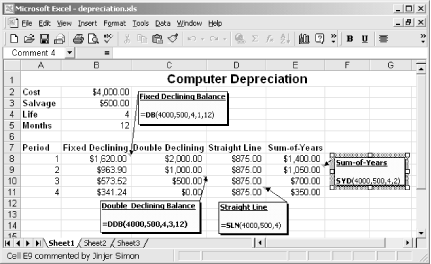Name
DB
Synopsis
Use DB to determine the amount of depreciation for an asset during the specified time frame. The depreciation is calculated using the fixed-declining balance method, which calculates the depreciation of the asset using a fixed rate.
To Calculate
=DB(Cost,Salvage,Life,Period,Month)
The Month argument is optional. All other
arguments must have a value.
-
Cost A numeric value that indicates the total amount paid to acquire the asset.
-
Life An integer value that indicates the number of periods that the asset will be depreciated over. For example, if you purchase a computer that will have a useful life of five years you would specify a value of
5for the Life argument.-
Period An integer value that indicates the period that you want to calculate the depreciation for, such as
2for the second year’s depreciation amount.-
Month An optional value that indicates the number of months in the first year of depreciation. If you omit this argument, the DB function will use a value of
12, meaning that the asset will be depreciated for the entire year.
Example
Figure 12-5 shows how you can use DB to determine the annual depreciation over four years for a computer that costs $4000 and has a salvage value of $500. This example also allows you to compare the results to the depreciation amounts calculated by DDB, SLN, and SYD.

Figure 12-5. Excel provides multiple functions for determining ...
Get Excel 2000 in a Nutshell now with the O’Reilly learning platform.
O’Reilly members experience books, live events, courses curated by job role, and more from O’Reilly and nearly 200 top publishers.

